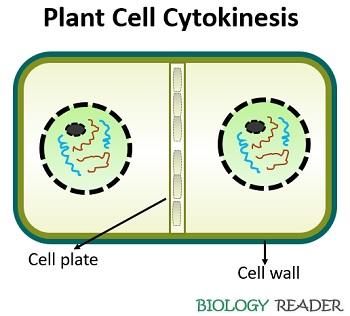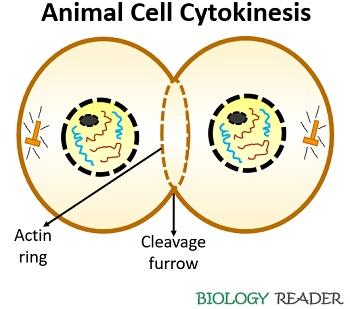What Are Two Differences Between Animal And Plant Cell Mitosis
The difference between establish and fauna cytokinesis is mainly due to the following factors like:
- Way of cytokinesis
- Cell abscission
Both the found and the animal jail cell divides their cytoplasmic contents equally between the two identical daughter cells only through different mechanisms. In a institute cell, the cytoplasmic division occurs via the fusion of phragmoplast associated vesicles at the metaphase plate. Oppositely, animal cell cytokinesis occurs via constriction of the concentric contractile band towards the middle of the prison cell.
Prison cell abscission is a stage, during which a mother cell separates into 2 halves with the same nucleocytoplasmic textile. Cell abscission In a plant prison cell takes identify through the expansion of prison cell plate towards the periphery. In contrast, cell abscission in the brute cell occurs via the ingression of cleavage furrow towards the centre.
Content: Plant Vs Animal Cytokinesis
- Comparison Chart
- Definition of Cytokinesis
- What is Cytokinesis in Plants?
- What is Cytokinesis in Animals?
- Key Differences
- Similarities
- Conclusion
Comparison Chart
| Properties | Plant Cytokinesis | Animal Cytokinesis |
|---|---|---|
| Meaning | Institute cell cytokinesis is a kind of cell move or cell division, which forms ii identical cells after a cell divides through the prison cell plate expansion | Fauna cell cytokinesis is a kind of cell motion or jail cell sectionalization, which forms two identical cells later a jail cell divides through the prison cell constriction or furrowing |
| Mode of cytokinesis | Hither, the cytokinesis occurs via a cleavage furrow or cell constriction mechanism | Here, the cytokinesis occurs via the fusion of phragmoplast associated associated vesicles |
| Occurrence | It begins from the prophase cell stage | It begins from the anaphase cell stage |
| Prison cell partition | A found cell partitions its cellular material equally between the two identical cells through the formation of concentric contractile microfilament ring | Creature prison cell partitions its cellular material as between the two identical cells through the formation of primal cell plate |
| Spindle fibres | Remnants of the spindle fibres persist | Hither, the spindle fibres degenerate |
| Cleavage furrow | Here, the formation of cleavage furrow doesn't appear | The formation of cleavage furrow occurs in the animal prison cell as a consequence of inward constriction of the actin ring |
| Vesicle formation | Modest membrane-spring vesicles are derived through the Golgi body | There is no such vesicle formation |
| Vesicle fusion | Here, the vesicles fuse that result in the cell plate formation by depositing the starchy material | Here, no such fusion occurs |
| Mid-body | Prison cell plate acts as a mid-body that contains remains of mitotic spindles and vesicles filled with cellular fabric | The contractile ring acts equally a mid-body that possesses actin and myosin filaments |
| Mid-trunk expansion | The mid-body extends from the centre to the lateral ends | The mid-trunk ingresses towards the centre from the peripheral ends |
| Cell abscission | Mother jail cell separates via centrifugal expansion of the jail cell plate | Female parent cell separates via centripetal expansion of a cleavage furrow |
Definition of Cytokinesis
The term cytokinesis merely refers to the jail cell motion or cell division. It is defined as a grade of cytoplasmic division, which occurs subsequently the chromosomal separation. In plants, the cytokinesis usually begins from the prophase stage of the jail cell cycle and lasts to the telophase stage. Oppositely, cytokinesis in the brute cells begins from the anaphase stage and occurs concurrently till the telophase stage of the jail cell cycle. It is the final stage of the cell cycle (both mitosis and meiosis), which divides a cell into two. By and large, the procedure of cytokinesis involves:
- The germination of the midbody
- Expansion or contraction of the midbody
- Cell division
- Formation of two identical daughter cells
Thus, it is a cell partitioning that facilitates the equal distribution of the cellular contents between the 2 daughter cells in case of both institute and animal cells. Information technology is an important result, which decides the successfulness of all the previously occurred mitotic events. Cytokinesis is the final, but the almost crucial stage of the cell segmentation wheel that is necessary for the growth and evolution of all the living cells, including plants and animals. Just, the mechanism of cytokinesis in both the plant and animate being cells differ, which we fill further study in this article.
What is Cytokinesis in Plants?
Cytokinesis in plants is defined as one of the cytological events, which uniformly divides the cellular contents of the mother jail cell between the 2 girl cells, every bit the cell partition occurs via the fusion of phragmoplast associated vesicles.
Here, the microtubule-organizing centres form microtubules, and the Golgi torso synthesizes many small membrane-bound vesicles that are filled with the cytoplasmic material of the plant prison cell.

During the telophase stage, the microtubules remnants or phragmoplast forms at the middle of the jail cell. The vesicles walk through the microtubules to reach the equator of the phragmoplast. Eventually, the vesicles will fuse.
The fusion of vesicles results in degradation of the starchy cloth within the plant prison cell, which is called a cell plate formation. Then, to form the prison cell wall, a few polysaccharide vesicles fuse to extend the cell plate laterally. As a outcome, the cell plate ultimately merges with the jail cell membrane and separates the parent prison cell into two identical girl cells.
What is Cytokinesis in Animals?
Cytokinesis in animals is defined every bit i of the cytological events that evenly distributes the cell fabric of the parent prison cell betwixt the ii girl cells after the prison cell partition occurs through a cleavage furrow or prison cell constriction method. Information technology starts from the anaphase stage and occurs concurrently till the telophase stage of the cell bicycle. The microfilaments constrict to form a concentric contractile ring in between the animal cell.
The concentric contractile ring acts equally a mid-torso that contains contractile bundles of the actin and myosin-II filaments. Actin filaments form at the division plane, and the myosin filaments pull these to form a ring-like structure inside the cell. This contractile band gradually contracts towards the centre or moves to the inward direction, by making a cleavage furrow.

A cell facilitates the uniform distribution of the cytoplasmic and nuclear contents through the mid-trunk. So, cell abscission occurs as the cleavage furrow ingresses from the periphery towards the centre, which results in cell segmentation of the parent cell. Two nascent cells will exist produced after the cell sectionalisation, where each will have the same proportion of the cytoplasmic material.
Primal Differences Between Plant and Animal Cytokinesis
- Cytokinesis but refers to the process of prison cell motion or prison cell division, in which both a establish and animal cell develops into two nascent cells via a cell plate and contractile ring formation, respectively.
- The mode of cytokinesis is one of the well-nigh critical features that differentiate the mechanism of the cell sectionalisation in the constitute and fauna jail cell. A plant jail cell produces daughter cells by the jail cell-constriction mechanism or through the germination of jail cell-furrow. Oppositely, the animal jail cell forms two nascent cells by the fusion of phragmoplast associated vesicles at the metaphase plate.
- Vesicles form during the telophase stage of the constitute cell, which after moves towards the phragmoplast and fuse with each other to develop a thick jail cell plate. But, in that location is no such vesicle formation, and fusion occurs during the cytokinesis of the animate being cells.
- Cell abscission occurs via a centripetal expansion of the contractile ring in animals, and through centrifugal expansion in plant cells.
- The germination of a mid-body during the cytokinesis process is one of the most striking features that differentiate the found and animal cell cytokinesis. A plant prison cell possesses a mid-body of phragmoplast (remains of mitotic spindles) and some vesicles filled with the cellular material. In contrast, an animal cell has a mid-torso of actin and myosin-2 microfilaments that form a concentric contractile ring within the cell.
Similarities
- Both the plant jail cell and animal cell cytokinesis are essential for cell growth and development.
- The cell division in plant and animal cell facilitates the equal distribution of the nuclear and cytoplasmic contents between the two girl cells.
- Both the plant cell and animal prison cell cytokinesis lasts till the telophase phase of the cell partitioning cycle.
- Both the processes occur later on the chromosomal segregation.
Determination
Thus, we can conclude that the process of cytokinesis is a crucial event in the jail cell cycle that ensures the uniform partitioning of the nuclear and cytoplasmic contents between the two developing cells. Cytokinesis generally involves the extensive restructuring of the cellular contents, and it begins subsequently the chromosomal segregation. In both plant and creature cell, the event of cytokinesis is a pivotal footstep for cell growth and evolution.
Source: https://biologyreader.com/difference-between-plant-and-animal-cytokinesis.html
Posted by: craftratepand.blogspot.com

0 Response to "What Are Two Differences Between Animal And Plant Cell Mitosis"
Post a Comment